Having evolved from basic 2D pictures, today’s tomographic images fascinate with high anatomical detail, making medical imaging more insightful than ever. But the increased amount of data to be processed has led to complications.
With images becoming more data-rich, radiologists are forced to focus on image analysis and reporting. As a result, they must leave interpretation to non-radiologists, which can negatively influence health outcomes. Budgetary constraints and an aging population coupled with the time-consuming process of image analysis is probably the reason for the catastrophic shortage of radiologists across Europe. The UK has the lowest number of trained medical imaging experts per capita — 4.7 radiologists per 100,000 people instead of the 8 radiologists needed.
But with so many demands placed on radiologists, hiring more will not suffice. Integrating technological enhancements like artificial intelligence in diagnostic radiology is necessary. In this article, you’ll learn more about the potential of AI in medical imaging and its possible applications.
The potential of AI in medical imaging

AI-based radiology software uses machine learning algorithms, big data, and computer vision for medical imaging to view and interpret MRIs, CT scans, CAT scans, and other images, augmenting a radiologist’s performance or sometimes functioning as a standalone tool.
The fundamental steps of classic machine learning and computer vision techniques in medical imaging include:
- Image acquisition and pre-processing — producing a digital image with image sensors
- Image segmentation — partitioning the digital image into segments, locating objects and boundaries, and categorizing the entire image into a class, such as “brain” or “lungs”
- Feature selection and extraction —identifying the most discriminant features
- Classification — analyzing the most discriminant features
For example, say we want to recognize a type of plant. First, we determine that an image is of a plant (image acquisition). Then we decide that one part is a stem and the other part is a leaf (segmentation). After that, we determine that the length of the stem and the color of the leaf are the most important features for identification (feature selection and extraction). Finally, after analyzing these two features, we decide that the plant is an eggplant, not a tomato (classification).
Applying artificial intelligence to image processing in the medical field has the immense potential to simplify and accelerate the entire radiological workflow while significantly reducing the rate of missed diagnoses and improving health outcomes. Below are a few characteristics of AI in radiology and practical values it already brings or might bring in the future.
Ability to process large volumes of data
AI-driven medical imaging solutions rely heavily on large volumes of medical data to train their machine learning algorithms to detect abnormal scans. When interpreting scans, AI-based solutions not only compare the scans with cases they’ve learned but also consider additional medical information, including previous scans of the same patient. This allows an AI solution to make diagnoses based on context, boosting precision manifold. Additionally, data obtained from previous scans can be uploaded into an electronic health record system for future reference.
Increased sensitivity to hidden abnormalities
AI-powered computer-aided diagnosis technologies can find abnormalities that the most experienced and detail-oriented radiologist is unable to catch. By giving radiologists consistent and reliable data, artificial intelligence in medical imaging can minimize subjectivity and variations in interpretations between radiologists. In this way, it can improve the reproducibility of radiological results.
Context-based interpretation
Using the power of computer vision in healthcare applications, AI systems can interpret images in context, making them similar to human radiologists. Since not all abnormalities are necessarily representative of a disease, ML algorithms in AI-based CAD solutions are trained on a case-by-case basis to see features invisible to the human eye. This makes them a decent alternative to conventional CAD systems, which just detect the absence or presence of visible features.
Read also: Computer Vision Application Examples
The characteristics mentioned above suggest that artificial intelligence can automate many routine tasks (such as detecting, characterizing, and quantifying abnormalities) as well as more complex tasks (such as interpreting findings within the clinical context).
The rising demand for processing large and complex datasets makes radiologists turn to AI-based technologies. As a result, the global AI in medical imaging market size is forecasted to expand at a compound annual growth rate (CAGR) of 34,8% by 2030.
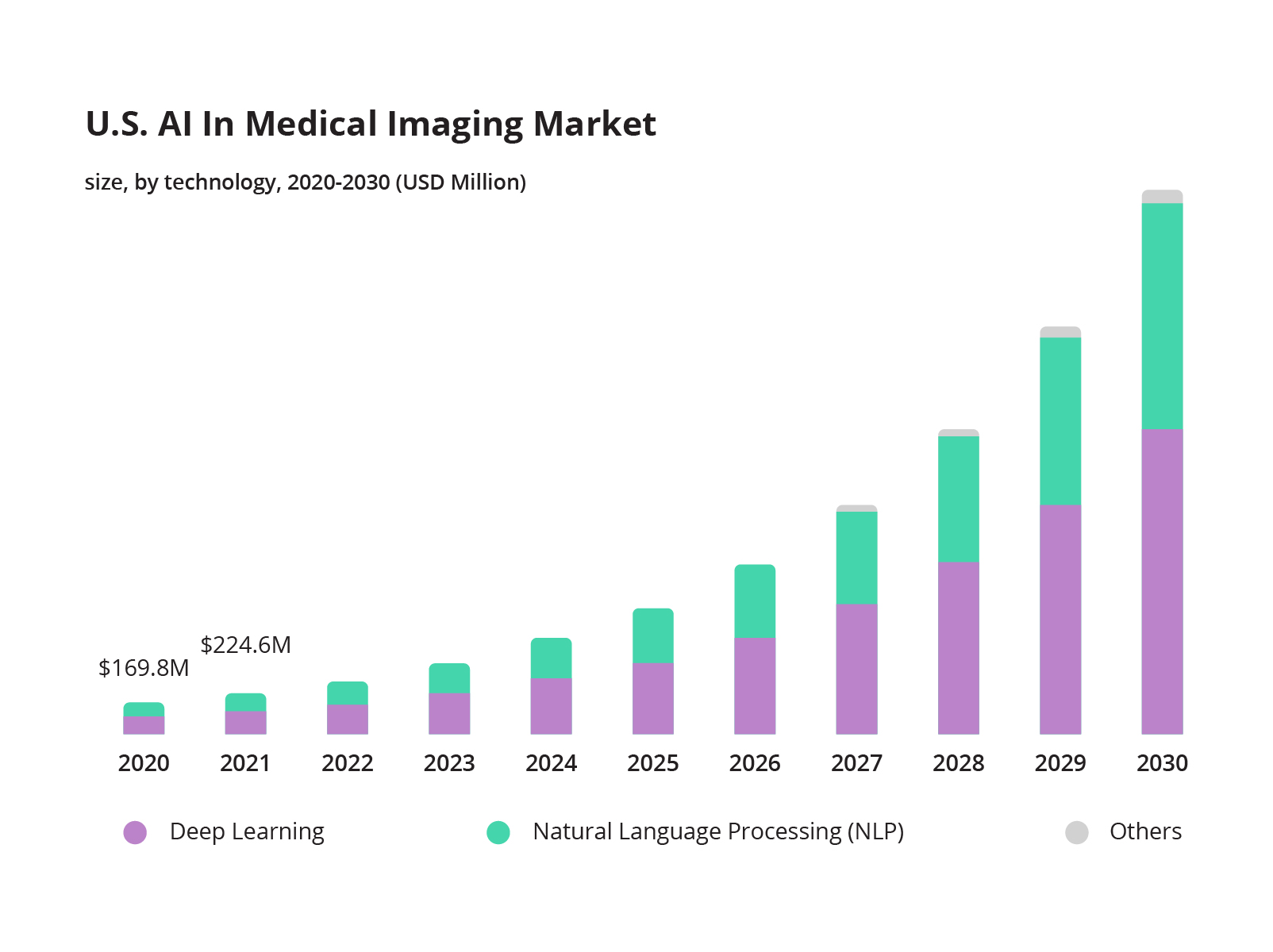
Source: Grand View Research
What practical improvements does AI bring?
Though AI-based medical image processing is only in its infancy, it has already brought certain practical improvements to the medical imaging field. In an article published in European Radiology Experimental, Filippo Pesapane, Marina Codari, and Francesco Sardanelli point out that AI in medical imaging is one of the most promising areas of health innovation.
AI holds tremendous opportunities for improvement of radiology and patient treatment.
| Fast image analysis and interpretation | With the load of images to interpret, radiologist’s role is reduced to image analysis only. The technology takes over a routine load, providing radiologists with more time for clinical judgment. AI can perform risk stratification and quickly identify cases without abnormalities, allowing radiologists to prioritize and dedicate time to patients who really need treatment while not prescribing unnecessary medication. |
|---|---|
| PImproved image quality | Radiologists can use AI to improve image quality that would lead to shorter MRI scanner sessions with less radiation doses. Images with better clarity and resolution will simplify technicians’ performance, leading to enhanced technical protocols and higher quality of examinations. |
| Accurate and early diagnosis | As the human eye may miss some patterns, AI can recognize anomalies and spot diseases at earlier stages. This way, radiologists can identify dangerous conditions faster and start treatment in time. |
| Automated workflows | One of the main tasks of AI is to automate routine tasks. Delegating image sorting and preliminary analysis to the technology, radiologists can focus on more complex cases and patient care. |
| Less errors and more effective communication | AI systems can ensure effective communication between technicians, radiologists, and other experts involved in medical image processing. The technology helps to reduce human error when it comes to image reviews, including technical protocols, or peer-to-peer information exchange. |
| Customized treatment plans | By providing detailed analyses of medical images and general health histories of each case, AI for medical diagnosis can help tailor treatment plans to the individual needs of patients. Such customized treatment plans will improve the overall effectiveness of treatments. |
As shown above, artificial intelligence can augment every stage of the medical imaging chain. But what about particular medical imaging areas? Let’s unpack this below.
AI techniques used in medical imaging
Radiologists have been at the forefront of applying digital technologies in health and treatment for ages. Machine learning, computer vision, and deep learning become quite common AI techniques used in medical imaging, helping radiologists revolutionize their field.
- Convolutional neural networks (CNNs)
Deep learning algorithms are particularly effective for analyzing visuals. Radiologists use CNNs for image classification, segmentation, and anomaly detection.
- Recurrent neural networks (RNNs)
Recurrent neural networks work best for processing sequential data or time-series data. In medical imaging, RNNs would work best for analyzing sequences of images and modeling the progression of diseases over time.
- Transfer learning
Transfer learning is a paradigm of fine-tuning a pre-trained AI model for a specific task. The applications of transfer learning vary from identifying diseases to interpreting x-rays.
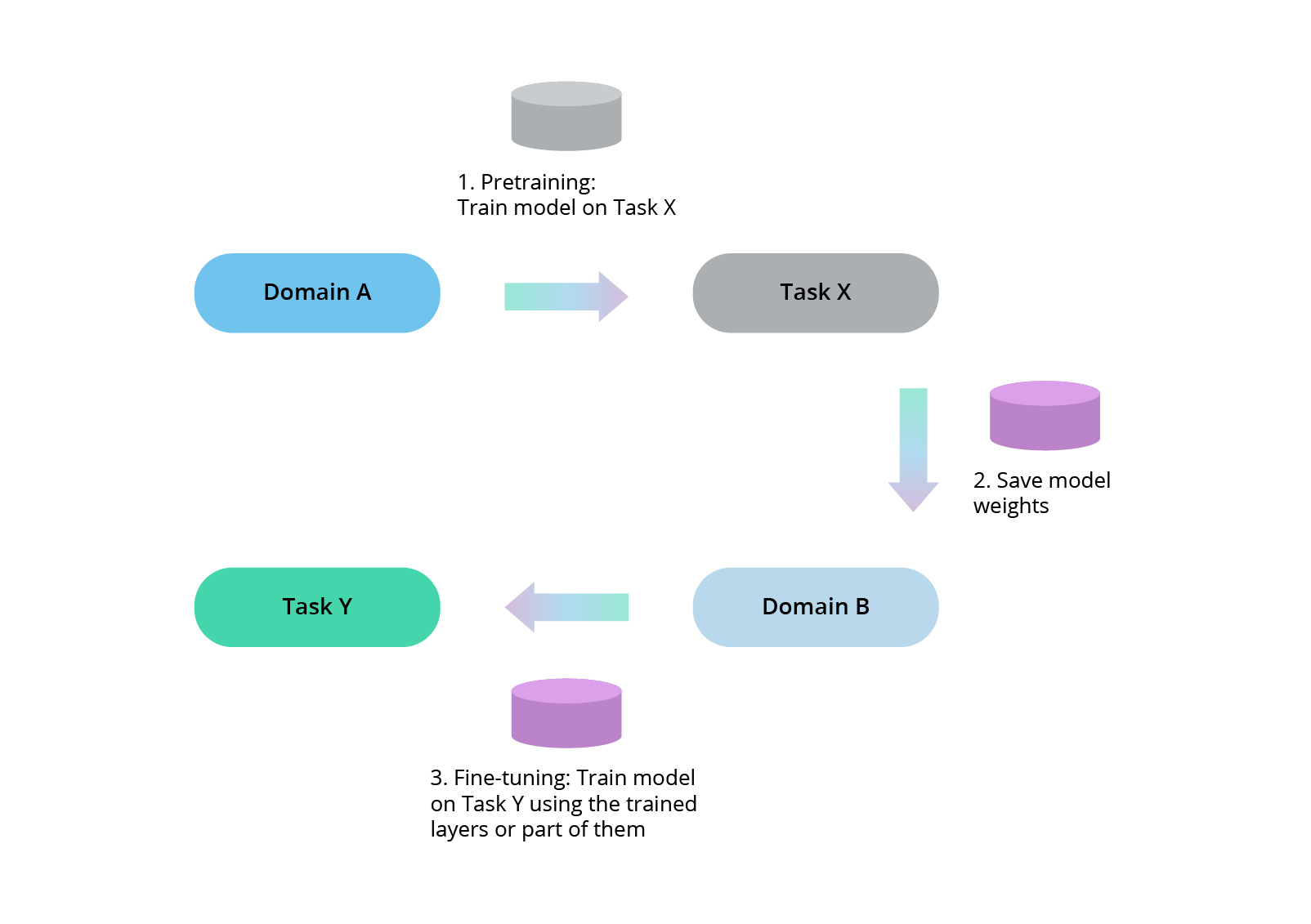
Source: AI Summer
- Generative adversarial networks (GANs)
GANs can generate new data that is similar to the input data. In medical imaging, they’re used for tasks such as data augmentation, image synthesis, and enhancing the resolution of medical images.
- Natural language processing (NLP)
NLP algorithms may be useful for paperwork. From interpreting results of medical reports to structuring relevant information, the technology complements findings from images.
Key segments in AI-based medical imaging
There’s no doubt that AI has the immense potential to revolutionize healthcare as a whole. But when it comes to medical imaging in particular, breast imaging, cardiovascular imaging, lung imaging, and neurological imaging are the key areas to benefit from artificial intelligence. Let’s see how.
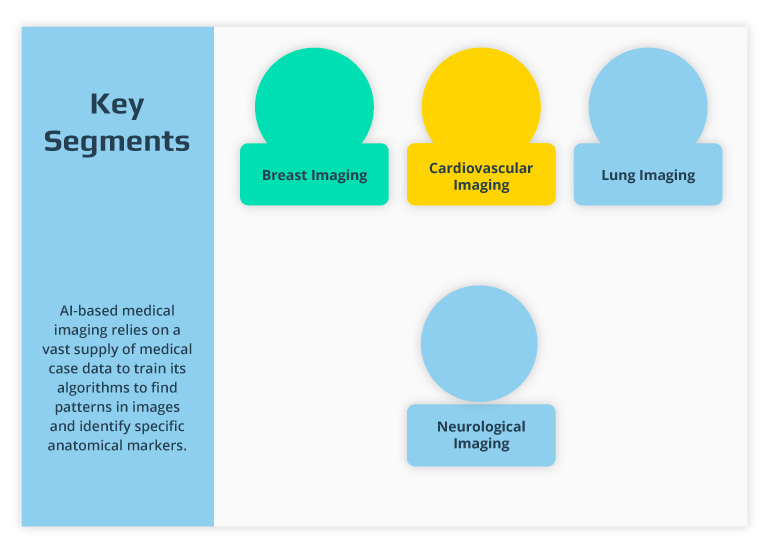
Lung imaging
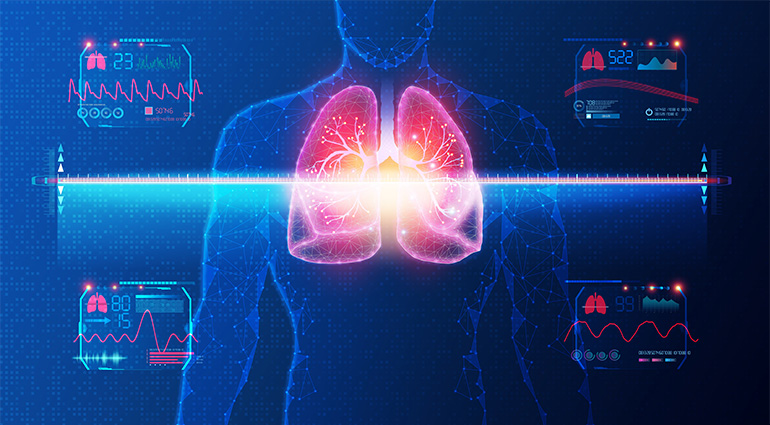
Producing high-resolution images of the lungs, AI-powered technology provides better quality of lung screening. Lung cancer is the most diagnosed form of cancer in many countries, and some advancements have been made in its early detection and treatment.
For example, an AI-based image evaluation solution developed by Google and Northwestern University Feinberg School of Medicine uses deep learning to detect malignant lung nodules on CT scans. While human radiologists normally view numerous 2D lung images, this solution examines lungs in a single huge 3D image, making the screening output more accurate. Besides, the system is trained to compare both primary and prior CT scans, which helps predict the risks of lung cancer malignancy. It analyzes both the region of interest and that with a high likelihood of lung cancer. This solution shows the same performance as expert radiologists when both primary and prior CT scans are available and outperforms them when a prior scan isn’t available.
Breast imaging

Artificial intelligence can tackle the main issues breast imagers face — missed cancers, false positives, and an ever-increasing workload. When combined with other innovative techniques such as digital breast tomosynthesis (3D mammography), which provides a remarkable level of detail, AI shows decent performance in the early detection of breast cancer.
Moreover, in a recent study, a group of radiologists showed better performance when using an AI algorithm as a decision support tool than when working on their own. Interestingly, when used as a standalone tool, the same algorithm demonstrated the average diagnostic performance of a human radiologist.
Another study aimed to reveal the risk stratification capabilities of AI-based algorithms and their potential to reduce a radiologist’s workload. In the study, the risk measurement system was trained to rank mammography examinations from 1 to 10 based on the likelihood of cancer presence. While scores from 1 to 5 were automatically considered normal, radiologists were assigned to examine cases scored 6 to 10. As a result, the overall workload was reduced by 47% with a 7% rate of missed cancer, which is very promising.
Brain (neurological) imaging
AI-driven algorithms in brain imaging help to detect abnormalities that are otherwise invisible. This is especially important for medication-resistant epilepsy patients for whom surgery is the only way to get rid of seizures. But the problem is that one-third of these patients have normal-looking MRI brain scans. And without locating seizure focal points, it’s impossible to perform surgery. However, a group of Canadian epilepsy experts seems to have tackled this problem with the help of machine learning.
In their experiment, the researchers used machine learning to train computers to read MRI scans that don’t reveal any visible abnormalities. The results were astonishing: the method allowed them to locate the focal point of seizures for a 27-year-old woman with normal-looking MRI scans. The woman underwent surgery and is now free of seizures.
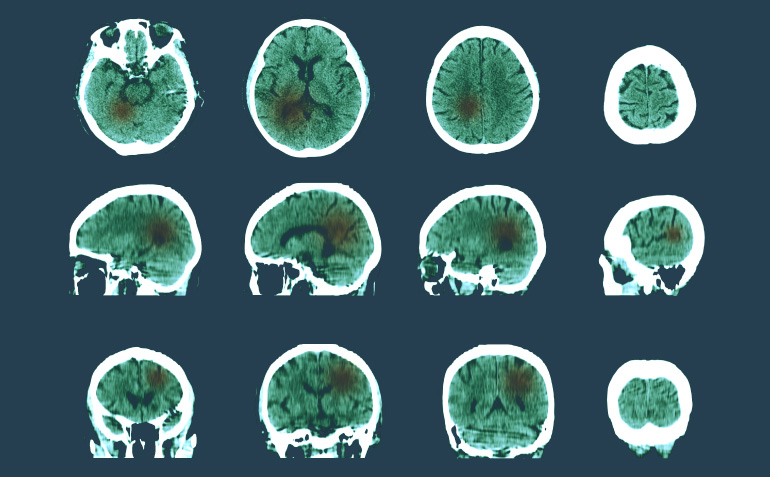
Cardiovascular imaging
AI in diagnostic imaging can be utilized in many steps of cardiovascular examinations, including image acquisition, segmentation, interpretation, and prediction of patient outcomes. Besides that, ML-driven algorithms are expected to become an integral part of standard cardiac imaging reporting and quantitative analysis software, gathering data and automatically performing risk stratification.
Certain solutions have already been implemented. HeartVista, developed by RTHawk, delivers detailed images quicker than any of its conventional counterparts. LVivo EF cardiac decision support software is the first AI-powered pocket-sized ultrasound that uses advanced pattern identification algorithms. Arterys is capable of partially automating a complex cardiac analysis.
Musculoskeletal imaging
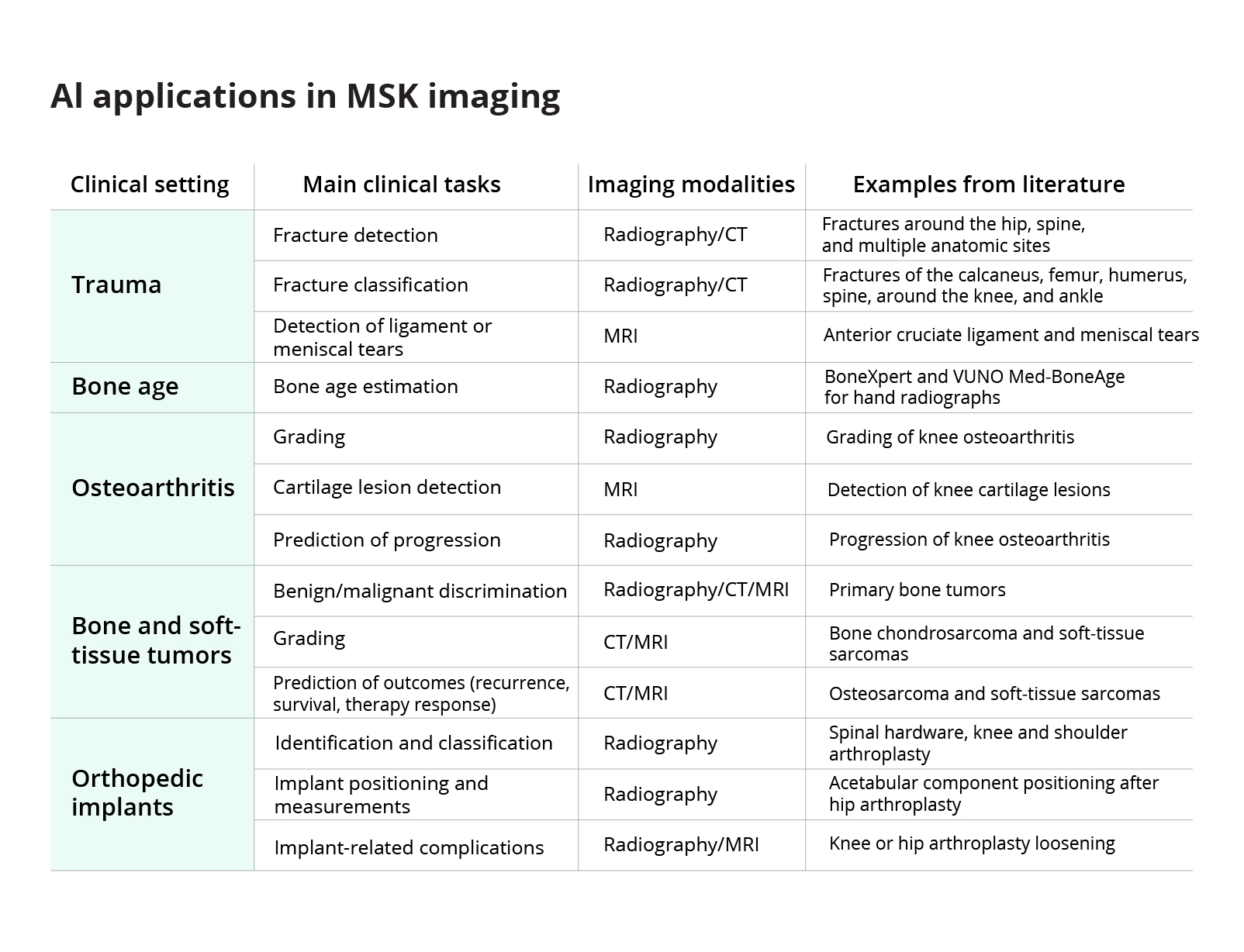
Source: SpringerOpen
AI holds the potential to take a load of routine and interpretative tasks off radiologists. The technology is poised to streamline workflows, serving as a tool to augment diagnostic performance and improve treatment outcomes.
Today, radiologists expect AI to cover a broad spectrum of applications, including trauma assessment, bone age estimation, diagnosing osteoarthritis, identifying tumors, detecting cancer, and evaluating orthopedic implants.
ChatGPT governance in medical institutions
Accuracy, reliability, and responsible use are the governance pillars of AI imaging in healthcare. Given the sensitivity and critical nature of medical data, it’s vital for any application of AI in radiology, including ChatGPT, to adhere to data privacy requirements.
Robust governance frameworks are necessary to protect patients’ privacy. Policies dictate strict measures like data encryption, secure storage, and rigorous testing and validation of the ChatGPT-generated content. Compliance with regulations like HIPAA in the United States or GDPR in Europe will ensure medical data security under the Ethics Guidelines for Trustworthy Artificial Intelligence by the European Commission.
Healthcare organizations have to establish bias mitigation and ethical use of the technology. Medical institutions are tasked with providing comprehensive staff training and oversight mechanisms to monitor AI imaging and diagnostics interactions.
Transparent processes will ensure the technology’s contributions are both beneficial and aligned with the patient care standards. Moreover, transparent communication with patients about using AI in medical image analysis and their care is a crucial aspect of governance.
Some popular AI-powered medical imaging platforms
The use of artificial intelligence for radiology is getting more approachable with AI-powered platforms for breast, lung, cardiovascular, and neurological imaging. Both tech startups and market leaders design these platforms to support radiologists in processing and interpreting X-rays, CT scans, MRI scans, and ultrasounds.
Let’s name some of the most popular:
Enlitic relies on deep learning, computer vision, and natural language processing algorithms to develop diagnostics software across various imaging modalities. The company aims to build the ultimate tools for radiology to standardize, protect, integrate, and analyze image data. Their products Enlitic Curie, ENDEX, and ENCOG facilitate healthcare systems globally.
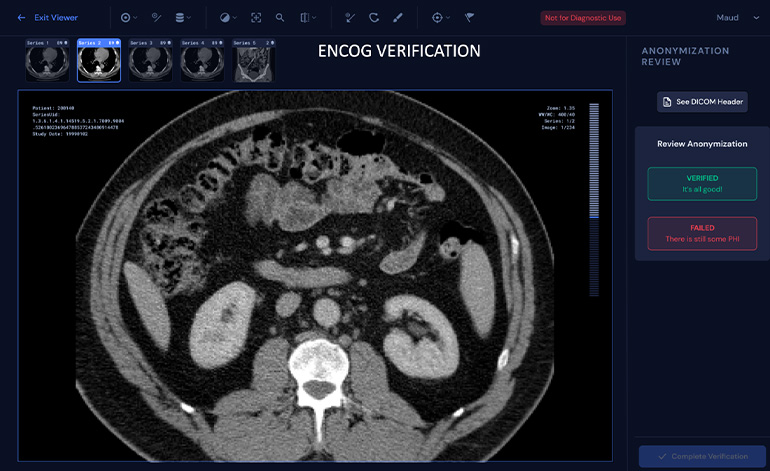
Source: Enlitic
- Zebra Medical Vision
Founded in 2014, Zebra is one of the most established and trusted medical image AI outsourcing companies in the field. Pioneering AI in radiology, Zebra Medical Vision developed 11 algorithms to identify cancer and liver, lung, and cardiovascular diseases in CT scans and X-rays.
Butterfly Network is a digital health company transforming ultrasound patient care for more than a decade. Their holistic point-of-care ultrasound solutions (POCUS) make medical imaging more accessible and interpretable, revolutionizing ultrasound examinations.
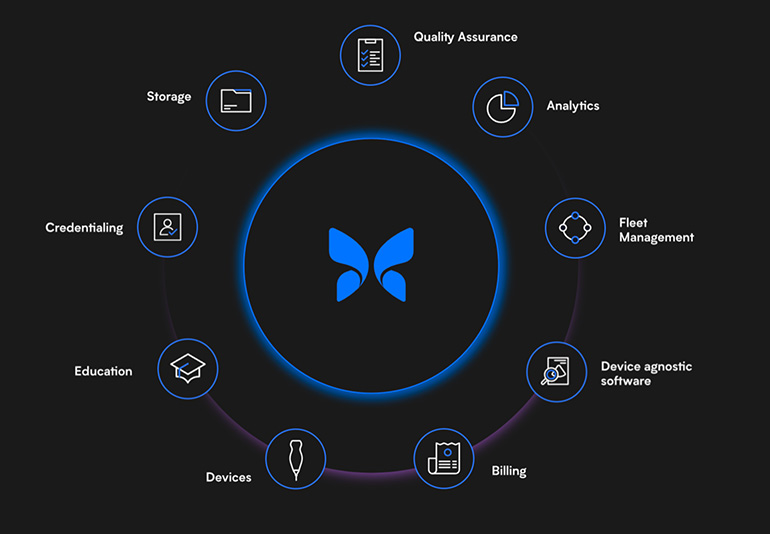
Source: Butterfly Network
Former Arterys, Tempus Radiology provides AI-powered solutions that help radiologists make data-driven decisions and improve treatment plans. Offering a suite of applications primarily for cardiovascular imaging, the company facilitates the visualization and interpretation of medical images.
- Zebra Medical Vision
Founded in 2014, Zebra is one of the most established and trusted medical image AI outsourcing companies in the field. Pioneering AI in radiology, Zebra Medical Vision developed 11 algorithms to identify cancer and liver, lung, and cardiovascular diseases in CT scans and X-rays.
Conclusion
The time-consuming process of analyzing images, complicated reporting routines, high rates of missed diagnoses, budgetary constraints, and a lack of trained radiologists have forced healthcare providers to turn their attention to artificial intelligence. AI in healthcare — and in medical imaging in particular — is only in its early development phase. However, compelling evidence of its effectiveness has already been revealed across the field’s key domains.
Today, it’s clear that AI can change medical imaging and make a significant impact on how healthcare companies globally treat their patients.
If you’re looking for a reliable software partner who specializes in building AI-based solutions for medical imaging, you’re in the right place. Contact our experts to learn more about applying artificial intelligence and advanced tech to optimize care pathways and improve treatment outcomes.



